Human body
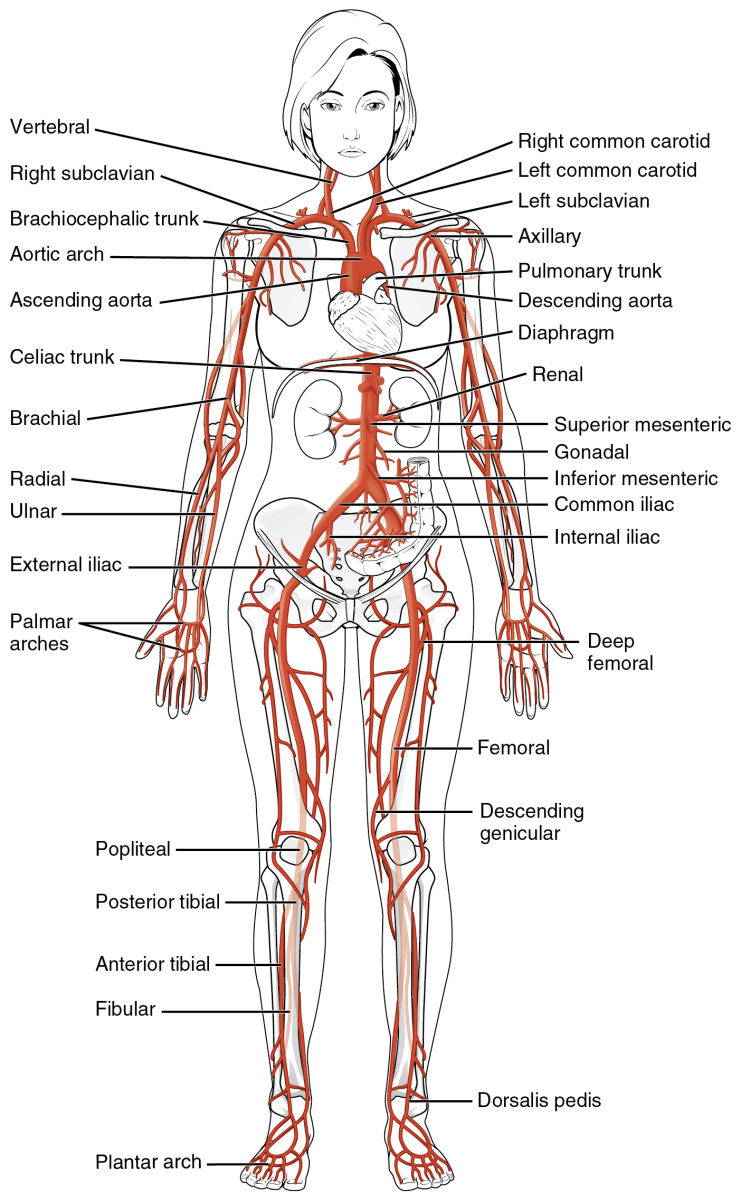
Human body
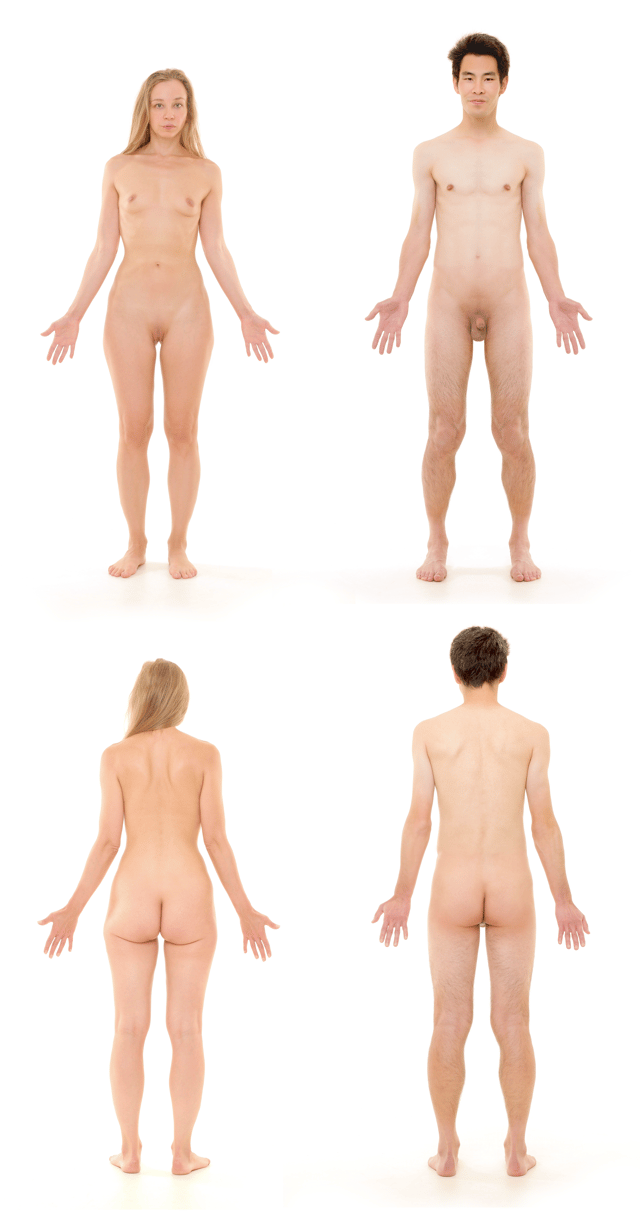
Female and male human bodies
The human body is the structure of a human being. It is composed of many different types of cells that together create tissues and subsequently organ systems. They ensure homeostasis and the viability of the human body.
It comprises a head, neck, trunk (which includes the thorax and abdomen), arms and hands, legs and feet.
The study of the human body involves anatomy, physiology, histology and embryology. The body varies anatomically in known ways. Physiology focuses on the systems and organs of the human body and their functions. Many systems and mechanisms interact in order to maintain homeostasis, with safe levels of substances such as sugar and oxygen in the blood.
The body is studied by health professionals, physiologists, anatomists, and by artists to assist them in their work.
Composition

Elements of the human body by mass. Trace elements are less than 1% combined (and each less than 0.1%).
The adult male body is about 60% water for a total water content of some 42 litres. This is made up of about 19 litres of extracellular fluid including about 3.2 litres of blood plasma and about 8.4 litres of interstitial fluid, and about 23 litres of fluid inside cells.[2] The content, acidity and composition of the water inside and outside cells is carefully maintained. The main electrolytes in body water outside cells are sodium and chloride, whereas within cells it is potassium and other phosphates.[3]
Cells
The body contains trillions of cells, the fundamental unit of life.[4] At maturity, there are roughly 30[5]–37[6] trillion cells in the body, an estimate arrived at by totaling the cell numbers of all the organs of the body and cell types. The body is also host to about the same number of non-human cells[5] as well as multicellular organisms which reside in the gastrointestinal tract and on the skin.[7] Not all parts of the body are made from cells. Cells sit in an extracellular matrix that consists of proteins such as collagen, surrounded by extracellular fluids. Of the 70 kg weight of an average human body, nearly 25 kg is non-human cells or non-cellular material such as bone and connective tissue.[5]
Cells in the body function because of DNA. DNA sits within the nucleus of a cell. Here, parts of DNA are copied and sent to the body of the cell via RNA.[8] The RNA is then used to create proteins which form the basis for cells, their activity, and their products. Proteins dictate cell function and gene expression, a cell is able to self-regulate by the amount of proteins produced.[9] However, not all cells have DNA – some cells such as mature red blood cells lose their nucleus as they mature.
Tissues
The body consists of many different types of tissue, defined as cells that act with a specialised function.[10] The study of tissues is called histology and often occurs with a microscope. The body consists of four main types of tissues – lining cells (epithelia), connective tissue, nervous tissue and muscle tissue.[11]
Cells that lie on surfaces exposed to the outside world or gastrointestinal tract (epithelia) or internal cavities (endothelium) come in numerous shapes and forms – from single layers of flat cells, to cells with small beating hair-like cilia in the lungs, to column-like cells that line the stomach. Endothelial cells are cells that line internal cavities including blood vessels and glands. Lining cells regulate what can and can't pass through them, protect internal structures, and function as sensory surfaces.[11]
Organs
Organs, structured collections of cells with a specific function,[12] sit within the body. Examples include the heart, lungs and liver. Many organs reside within cavities within the body. These cavities include the abdomen (which contains the stomach, for example) and pleura, which contains the lungs.
Systems
Circulatory system

The circulatory system consists of the heart and blood vessels (arteries, veins and capillaries). The heart propels the circulation of the blood, which serves as a "transportation system" to transfer oxygen, fuel, nutrients, waste products, immune cells and signalling molecules (i.e. hormones) from one part of the body to another. Paths of blood circulation within the human body can be divided into two circuits: the pulmonary circuit, which pumps blood to the lungs to receive oxygen and leave carbon dioxide, and the systemic circuit, which carries blood from the heart off to the rest of the body. The blood consists of fluid that carries cells in the circulation, including some that move from tissue to blood vessels and back, as well as the spleen and bone marrow.[13][14][15][16]
Digestive system

The digestive system consists of the mouth including the tongue and teeth, esophagus, stomach, (gastrointestinal tract, small and large intestines, and rectum), as well as the liver, pancreas, gallbladder, and salivary glands. It converts food into small, nutritional, non-toxic molecules for distribution and absorption into the body. These molecules take the form of proteins (which are broken down into amino acids), fats, vitamins and minerals (the last of which are mainly ionic rather than molecular). After being swallowed, food moves through the gastrointestinal tract by means of peristalsis: the systematic expansion and contraction of muscles to push food from one area to the next.[17][18]
Digestion begins in the mouth, which chews food into smaller pieces for easier digestion. Then it is swallowed, and moves through the esophagus to the stomach. In the stomach, food is mixed with gastric acids to allow the extraction of nutrients. What is left is called chyme; this then moves into the small intestine, which absorbs the nutrients and water from the chyme. What remains passes on to the large intestine, where it is dried to form feces; these are then stored in the rectum until they are expelled through the anus.[19]
Endocrine system

The endocrine system consists of the principal endocrine glands: the pituitary, thyroid, adrenals, pancreas, parathyroids, and gonads, but nearly all organs and tissues produce specific endocrine hormones as well. The endocrine hormones serve as signals from one body system to another regarding an enormous array of conditions, and resulting in variety of changes of function.[20]
Immune system

The immune system consists of the white blood cells, the thymus, lymph nodes and lymph channels, which are also part of the lymphatic system. The immune system provides a mechanism for the body to distinguish its own cells and tissues from outside cells and substances and to neutralize or destroy the latter by using specialized proteins such as antibodies, cytokines, and toll-like receptors, among many others.[21]
Integumentary system
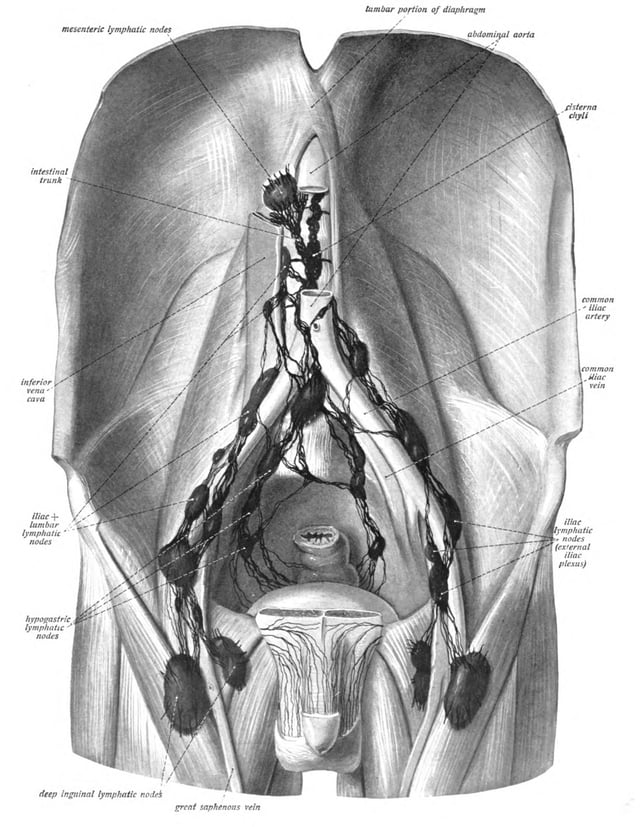
The integumentary system consists of the covering of the body (the skin), including hair and nails as well as other functionally important structures such as the sweat glands and sebaceous glands. The skin provides containment, structure, and protection for other organs, and serves as a major sensory interface with the outside world.[22][23]
Lymphatic system
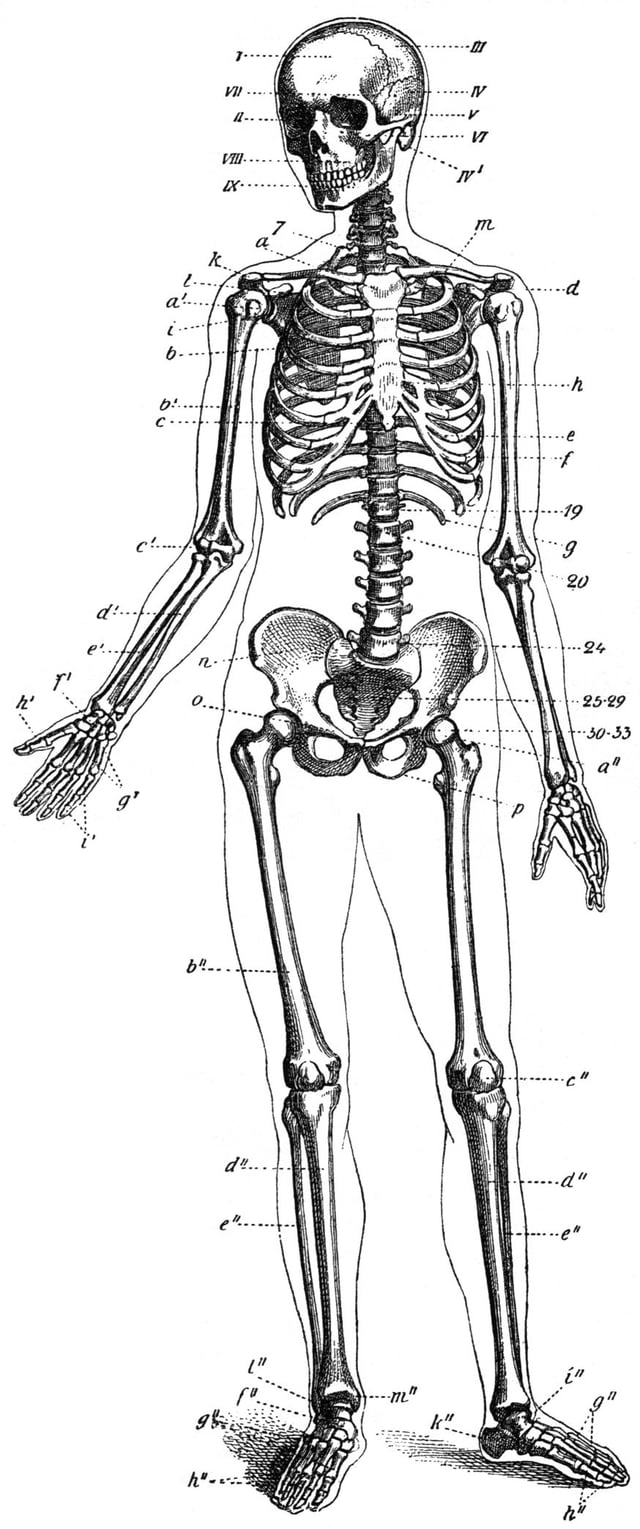
The lymphatic system extracts, transports and metabolizes lymph, the fluid found in between cells. The lymphatic system is similar to the circulatory system in terms of both its structure and its most basic function, to carry a body fluid.[24]
Musculoskeletal system
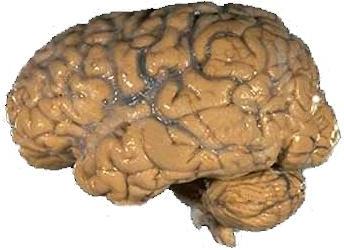
The musculoskeletal system consists of the human skeleton (which includes bones, ligaments, tendons, and cartilage) and attached muscles. It gives the body basic structure and the ability for movement. In addition to their structural role, the larger bones in the body contain bone marrow, the site of production of blood cells. Also, all bones are major storage sites for calcium and phosphate. This system can be split up into the muscular system and the skeletal system.[25]
Nervous system

The nervous system consists of the body's neurons, which together form the nerves and ganglia which in turn form the brain and related structures. The brain is the organ of thought, emotion, memory, and sensory processing; it serves many aspects of communication and controls various systems and functions. The special senses consist of vision, hearing, taste, and smell. The eyes, ears, tongue, and nose gather information about the body's environment.[26]
From a structural perspective, the nervous system is typically subdivided into two component parts: the central nervous system (CNS), composed of the brain and the spinal cord; and the peripheral nervous system (PNS), composed of the nerves and ganglia outside the brain and spinal cord. The CNS is mostly responsible for organizing motion, processing sensory information, thought, memory, cognition and other such functions.[27] It remains a matter of some debate whether the CNS directly gives rise to consciousness.[28] The peripheral nervous system (PNS) is mostly responsible for gathering information with sensory neurons and directing body movements with motor neurons.[29]
From a functional perspective, the nervous system is again typically divided into two component parts: the somatic nervous system (SNS) and the autonomic nervous system (ANS). The SNS is involved in voluntary functions like speaking and sensory processes. The ANS is involved in involuntary processes, such as digestion and regulating blood pressure.[30]
The nervous system is subject to many different diseases. In epilepsy, abnormal electrical activity in the brain can cause seizures. In multiple sclerosis, the immune system attacks the nerve linings, damaging the nerves' ability to transmit signals. Amyotrophic Lateral Sclerosis (ALS), also known as Lou Gehrig's disease, is a motor neuron disease which gradually reduces movement in patients. There are also many other diseases of the nervous system.[31]
Reproductive system

The reproductive system consists of the gonads and the internal and external sex organs. The reproductive system produces gametes in each sex, a mechanism for their combination, and in the female a nurturing environment for the first 9 months of development of the infant.[32]
Respiratory system
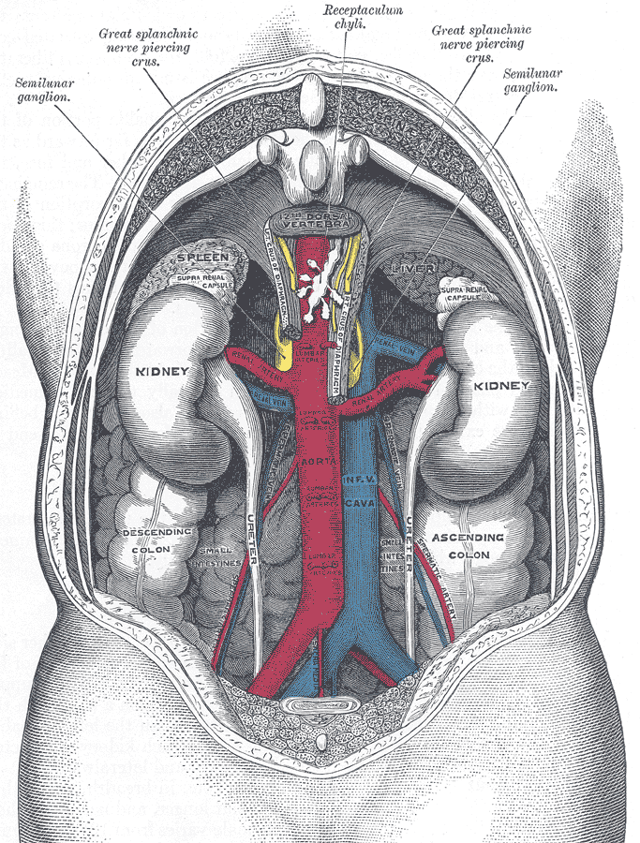
The respiratory system consists of the nose, nasopharynx, trachea, and lungs. It brings oxygen from the air and excretes carbon dioxide and water back into the air. First, air is pulled through the trachea into the lungs by the diaphragm pushing down, which creates a vacuum. Air is briefly stored inside small sacs known as alveoli (sing.: alveolus) before being expelled from the lungs when the diaphragm contracts again. Each alveolus]] is surrounded by capillaries carrying deoxygenated blood, which absorbs oxygen out of the air and into the bloodstream.[33][34]
For the respiratory system to function properly, there need to be as few impediments as possible to the movement of air within the lungs. Inflammation of the lungs and excess mucus are common sources of breathing difficulties.[35] In asthma, the respiratory system is persistently inflamed, causing wheezing and/or shortness of breath. Pneumonia occurs through infection of the alveoli, and may be caused by tuberculosis. Emphysema, commonly a result of smoking, is caused by damage to connections between the alveoli.[36]
Urinary system
Anatomy
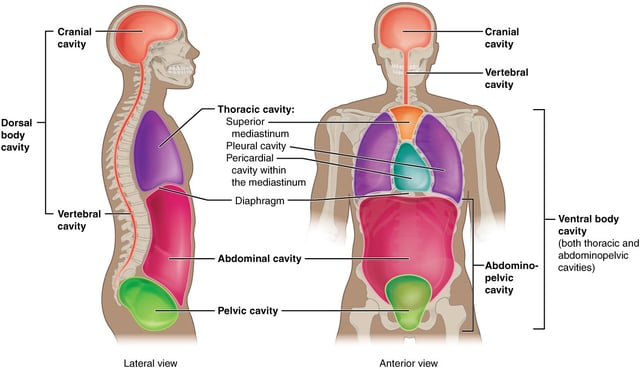
Cavities of human body
Human anatomy is the study of the shape and form of the human body. The human body has four limbs (two arms and two legs), a head and a neck which connect to the torso. The body's shape is determined by a strong skeleton made of bone and cartilage, surrounded by fat, muscle, connective tissue, organs, and other structures. The spine at the back of the skeleton contains the flexible vertebral column which surrounds the spinal cord, which is a collection of nerve fibres connecting the brain to the rest of the body. Nerves connect the spinal cord and brain to the rest of the body. All major bones, muscles, and nerves in the body are named, with the exception of anatomical variations such as sesamoid bones and accessory muscles.
Blood vessels carry blood throughout the body, which moves because of the beating of the heart. Venules and veins collect blood low in oxygen from tissues throughout the body. These collect in progressively larger veins until they reach the body's two largest veins, the superior and inferior vena cava, which drain blood into the right side of the heart. From here, the blood is pumped into the lungs where it receives oxygen and drains back into the left side of the heart. From here, it is pumped into the body's largest artery, the aorta, and then progressively smaller arteries and arterioles until it reaches tissue. Here blood passes from small arteries into capillaries, then small veins and the process begins again. Blood carries oxygen, waste products, and hormones from one place in the body to another. Blood is filtered at the kidneys and liver.
The body consists of a number of body cavities, separated areas which house different organ systems. The brain and central nervous system reside in an area protected from the rest of the body by the blood brain barrier. The lungs sit in the pleural cavity. The intestines, liver, and spleen sit in the abdominal cavity
Physiology
Human physiology is the study of how the human body functions. This includes the mechanical, physical, bioelectrical, and biochemical functions of humans in good health, from organs to the cells of which they are composed. The human body consists of many interacting systems of organs. These interact to maintain homeostasis, keeping the body in a stable state with safe levels of substances such as sugar and oxygen in the blood.[39]
Each system contributes to homeostasis, of itself, other systems, and the entire body. Some combined systems are referred to by joint names. For example, the nervous system and the endocrine system operate together as the neuroendocrine system. The nervous system receives information from the body, and transmits this to the brain via nerve impulses and neurotransmitters. At the same time, the endocrine system releases hormones, such as to help regulate blood pressure and volume. Together, these systems regulate the internal environment of the body, maintaining blood flow, posture, energy supply, temperature, and acid balance (pH).[39]
Development
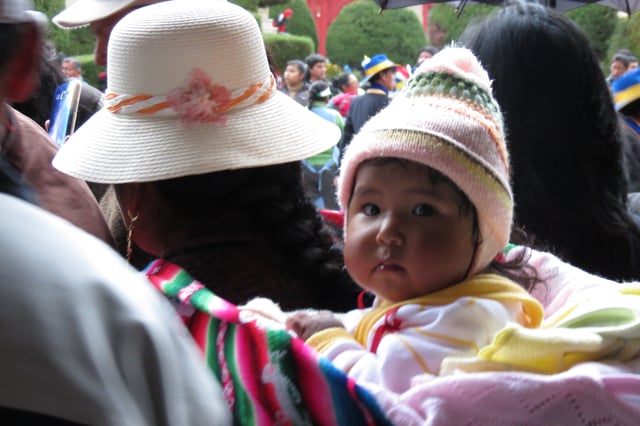
Baby being carried
Development of the human body is the process of growth to maturity. The process begins with fertilisation, where an egg released from the ovary of a female is penetrated by sperm. The egg then lodges in the uterus, where an embryo and later fetus develop until birth. Growth and development occur after birth, and include both physical and psychological development, influenced by genetic, hormonal, environmental and other factors. Development and growth continue throughout life, through childhood, adolescence, and through adulthood to senility, and are referred to as the process of ageing.
Society and culture
Professional study
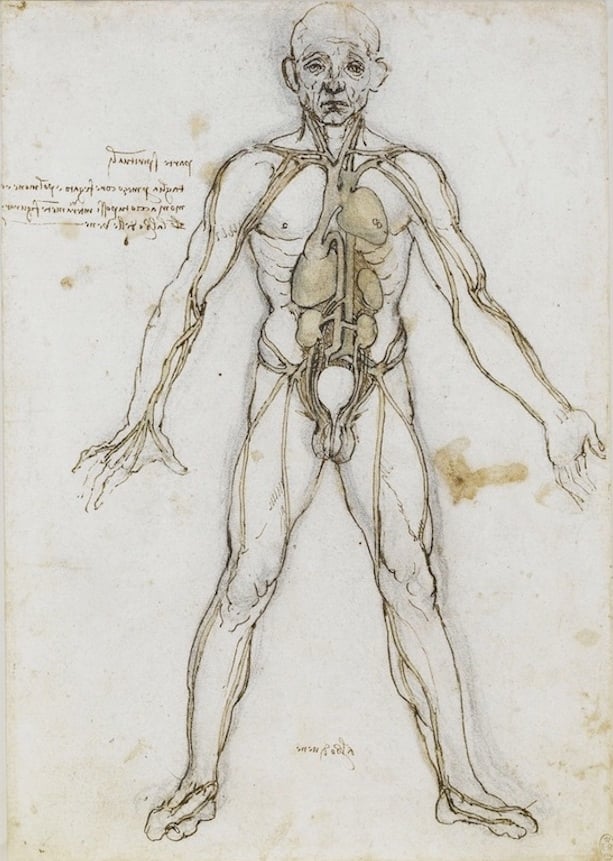
Anatomical study by Leonardo da Vinci
Health professionals learn about the human body from illustrations, models, and demonstrations. Medical and dental students in addition gain practical experience, for example by dissection of cadavers. Human anatomy, physiology, and biochemistry are basic medical sciences, generally taught to medical students in their first year at medical school.[40][41][42]
Depiction

Figure drawing by Lovis Corinth (before 1925)
Anatomy has served the visual arts since Ancient Greek times, when the 5th century BC sculptor Polykleitos wrote his Canon on the ideal proportions of the male nude.[43] In the Italian Renaissance, artists from Piero della Francesca (c. 1415–1492) onwards, including Leonardo da Vinci (1452–1519) and his collaborator Luca Pacioli (c. 1447–1517), learnt and wrote about the rules of art, including visual perspective and the proportions of the human body.[44]
History of anatomy
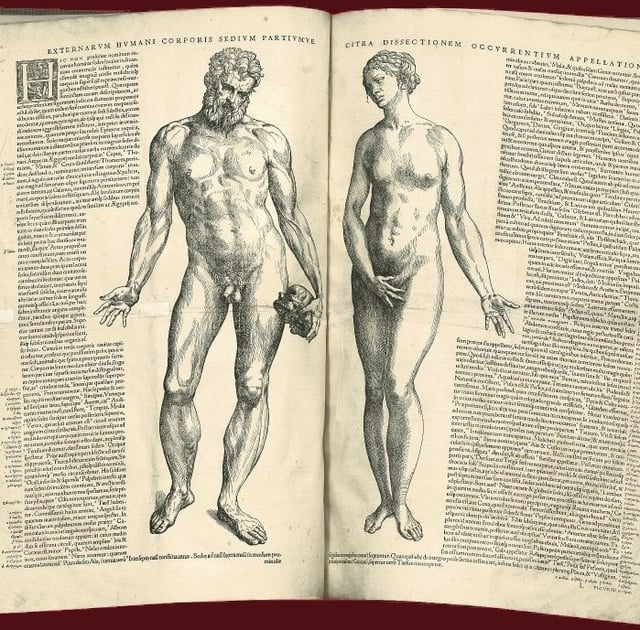
Two facing pages of text with woodcuts of naked male and female figures, in the Epitome by Andreas Vesalius, 1543
In Ancient Greece, the Hippocratic Corpus described the anatomy of the skeleton and muscles.[45] The 2nd century physician Galen of Pergamum compiled classical knowledge of anatomy into a text that was used throughout the Middle Ages.[46] In the Renaissance, Andreas Vesalius (1514–1564) pioneered the modern study of human anatomy by dissection, writing the influential book De humani corporis fabrica.[47][48] Anatomy advanced further with the invention of the microscope and the study of the cellular structure of tissues and organs.[49] Modern anatomy uses techniques such as magnetic resonance imaging, computed tomography, fluoroscopy and ultrasound imaging to study the body in unprecedented detail.[50]
History of physiology
The study of human physiology began with Hippocrates in Ancient Greece, around 420 BC, and with Aristotle (384–322 BC) who applied critical thinking and emphasis on the relationship between structure and function. Galen (c. 126–199) was the first to use experiments to probe the body's functions.[51] The term physiology was introduced by the French physician Jean Fernel (1497–1558).[52] In the 17th century, William Harvey (1578–1657) described the circulatory system, pioneering the combination of close observation with careful experiment.[53] In the 19th century, physiological knowledge began to accumulate at a rapid rate with the cell theory of Matthias Schleiden and Theodor Schwann in 1838, that organisms are made up of cells.[52] Claude Bernard (1813–1878) created the concept of the milieu interieur (internal environment), which Walter Cannon (1871–1945) later said was regulated to a steady state in homeostasis. In the 20th century, the physiologists Knut Schmidt-Nielsen and George Bartholomew extended their studies to comparative physiology and ecophysiology.[54] Most recently, evolutionary physiology has become a distinct subdiscipline.[55]
Religions
Theology of the body of John Paul II
20th c. saw a rise of interest in reflection about human body in the light of Christian faith. One of the most significant contributions was that given by pope John Paul II in his catecheses held at the Vatican during Wednesday general audiences. It received the name of the Theology of the Body. In his catecheses John Paul II presented an interpretation of the fundamental significance of the body, and in particular of sexual differentiation and complementarity, one which aims to challenge common contemporary philosophical views.[56] In his approach to the subject, the pope used personalistic phenomenology but also was "echoing what he learned from St. John of the Cross"[57] and was "in harmony with St. Thomas Aquinas".[58]
See also
Medicine – The science and practice of the diagnosis, treatment, and prevention of physical and mental illnesses
Glossary of medicine
Cell physiology
Comparative physiology
Comparative anatomy
Development of the human body
